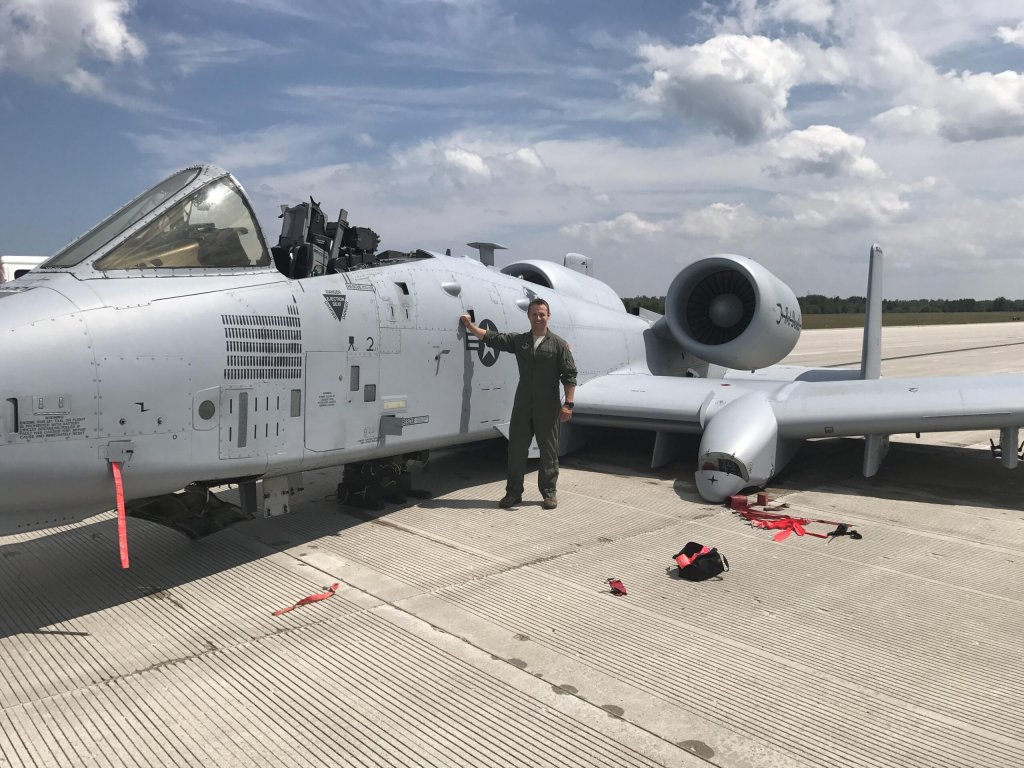

On July 20, 2017, Capt. Brett DeVries of the 107th Fighter Squadron at Selfridge Air National Guard Base in Michigan was on a training flight when his A-10 Thunderbolt II suffered a catastrophic failure. The A-10’s iconic GAU-8 Avenger rotary cannon malfunctioned and sent a blast of gas through the aircraft. As a result, the canopy and multiple panels blew off while DeVries was flying at 325 knots. Other systems failed on board and DeVries’ head was slammed back in his seat. After gathering himself and assessing the situation, DeVries and his wingman decided to fly 250 miles to nearby Alpena airfield.
On approach for an emergency landing, DeVries’ A-10 experienced yet another problem. His wingman informed him that the aircraft’s nose wheel was hung up and the main gear didn’t deploy at all. Rather than attempt to land with partially extended gear, DeVries decided to make a belly landing with his convertible Thunderbolt. With great skill and discipline, DeVries managed to set his stricken aircraft down smoothly and skid to a halt on the flightline. He received the Distinguished Flying Cross for his actions that day.
Although the damage to the A-10 was extensive, the Thunderbolt was designed to take a beating. Air Force officials contacted the service’s elite team of A-10 experts at Hill Air Force Base in Utah to evaluate the aircraft and see what, if anything could be salvaged. In July 2018, the A-10 arrived at Hill AFB in pieces, strapped to flatbed trucks.

Incredibly, the experts of the 309th Aircraft Maintenance Group assessed that the A-10, tail number 80-0264, could be repaired and returned to flight status. “We knew we could do it, but it would take a long time,” said Daniel Wise, 571st Aircraft Maintenance Squadron A-10 planning chief to the 75th Air Base Wing Public Affairs. “We basically rebuilt the entire front of the A-10 without aided engineering and un-procurable parts that had to be local manufactured.”
Despite the unconventional landing, most of the significant damage to the A-10 was the result of the cannon’s malfunction. “There’s a main nose bean right next to the gun that blew up, so the inside of the entire gun cavity had to be rebuilt,” Scott Oster, 571st AMXS lead A-10 planner, told the 75th Air Base Wing Public Affairs. “It was just a whole lot of structural work, like 90%.”

To further complicate the repair, Air Force supply chains are less than supportive of the A-10 and many parts simply aren’t available. Contracts to manufacture some of the parts needed could take up to two years to fulfill. “A lot of the parts are unavailable so we have to run them through our local manufacturing process and make them ourselves,” Oster said. “With any of the other weapons systems, if they have a bad part, they order it through supply and replace it. On the A-10’s, we’re kind of in a different world.”
The 309th Maintenance Group at Hill AFB manufactured every part that wasn’t readily available. Through the local manufacturing process, the engineers made the part, heat-treated it, surface-treated it, and managed to get it on the plane in about two weeks. After over three years of hard work, the A-10 was ready to return to the skies.

On October 22, 2021, Maj. Kyle “Soap” Schafer of the 514th Flight Test Squadron at Hill AFB took the A-10 up for a test flight. Following a series of evaluations, the aircraft was returned to its home station with the Michigan Air National Guard; and it’s all thanks to the A-10 experts at Hill. “Our planners, schedulers, engineers, parts makers and everyone on the floor who put this legacy airframe back together are totally appreciated for their skill and overall effort,” Wise said. “We’re all pretty passionate about keeping the A-10 alive and in the air. It’s America’s number-one choice for close-air support and getting 264 ready to fly back home is really something to be proud of.”
